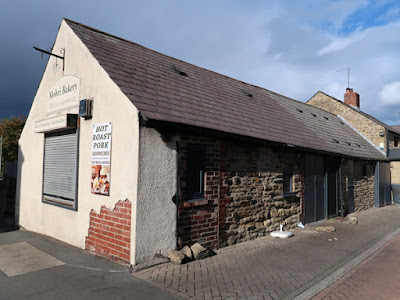Leaving the hamlet of Whitley, having had a quick look at its historic buildings and a small roadside outcrop of the Penistone Flags, I set off across the fields along the public footpath with an original idea to go and look for the old Hunshelf Quarry.
Descending into a vale cut by a stream into the underlying Pennine Lower Coal Measures Formation (PLCMF) mudstones, with a sharp rise up to an escarpment formed by a thin band of the Penistone Flags, I didn’t consider it worth the effort to go searching for an old quarry that might now be very overgrown and followed another path to Whitley Lane and continued along this until I eventually reached Church Street.
Passing a few stone built C19 terraced and interwar semi-detached houses of no great merit, I encountered a long boundary wall that was originally built in thinly bedded silty sandstone that is now deeply weathered, upon which several courses of a more massive and durable PLCMF sandstone has been added.
Into this has been set a very abstract carved face, which is an early example of the work of Sheffield based artist Andrew Vickers of Stoneface Creative, whose various sculptures I have seen in many places across the city.
I had last visited Ecclesfield in October 2016, to take advantage of the opening of St. Mary’s church, but all of my photographs of its exterior and interior were lost when my external hard drive unexpectedly failed and I went to have another quick look at its exterior and churchyard, which I shall describe in my next post.
Ecclesfield cemetery is next to the church and I went to have a quick look to see if I could find any Commonwealth War Graves Commission headstones, but the seven of these are all made in Portland stone and none belong to regiments that I had not seen before; however, a private headstone with some interesting coloured decoration caught my eye, as well as a slab made in grey Cornish granite with large phenocrysts.
Having had a good chat with a local, who told me some interesting things about the area, I returned to Town End Road and took photographs of a few older buildings that are built with a yellowish sandstone that is probably Grenoside Sandstone.
Making my way back to Church Street, I came a cross the first of a few listed buildings that I wanted to photograph for the British Listed Buildings website – the early C19 red brick Nos. 8 and 10 – before continuing along High Street to the former cruck barn attached to the south end of No. 35 St Mary's Lane.
A little further down High Street is the filemakers' manufactory immediately to the north-west of No.11. As with many of the small villages on the outskirts of Sheffield, Ecclesfield was the home to various industries, including scythe makers, nail makers and paper and corn mills.
As I continued along High Street, the sky began to darken menacingly and, having photographed a few more unlisted historic buildings that are again probably built with Grenoside Sandstone from Grenoside, the heavens opened.
I had to take shelter for several minutes before I was able to continue along High Street to find the nearest bus stop, from which I would catch a No. 83 bus back to Sheffield after another very good walk of more than 8 km.












No comments:
Post a Comment